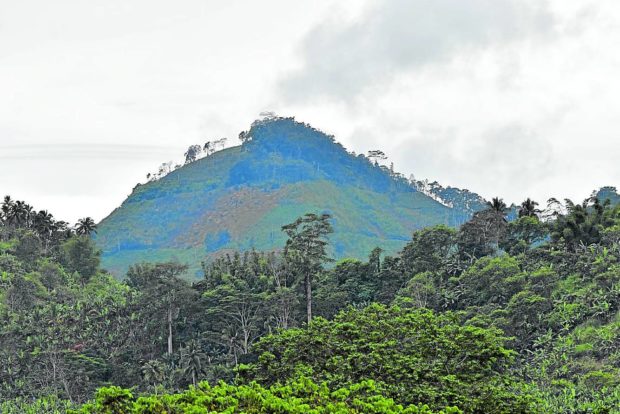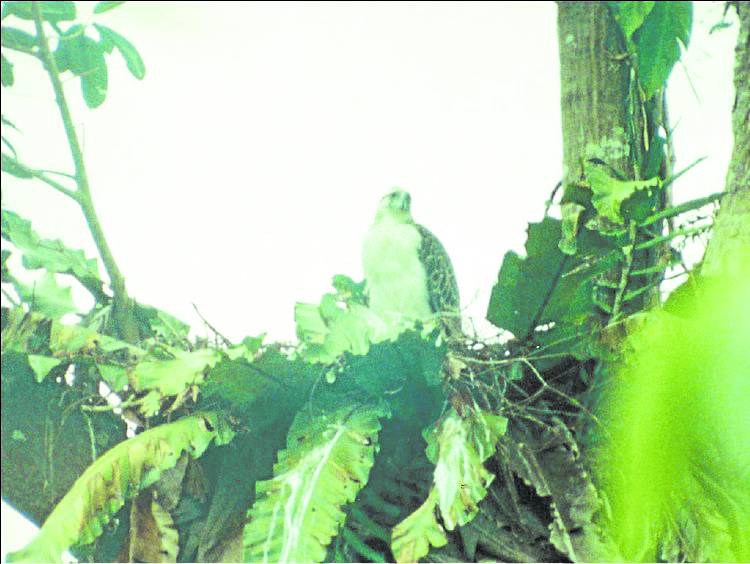
PROTECTION SOUGHT Environmental groups want Mt. Makabol in Davao City protected against forest destruction to save the nesting sites of Philippine eagles. A file photo from Philippine Eagle Foundation shows an eagle nesting site (below) some 200 meters away from the old-growth trees set to be cut on Makabol. —PHOTO CONTRIBUTED BY BENITO ANTHONY PINGOY AND PHILIPPINE EAGLE FOUNDATION
DAVAO CITY—The Department of Environment and Natural Resources (DENR) has suspended the cutting of old-growth trees in Makabol forest in Barangay Salaysay here that could put at risk the nesting site of the critically endangered Philippine eagle and the water source of nearby communities.
But lawyer Mark Peñalver, executive director of the environment group Interface for Development Intervention (Idis), said there was nothing new with the announcement as the DENR had been promising this since November.
Peñalver said Idis would not rest until the DENR would issue a cease-and-desist order against the cutting of trees and affirm the area as a protected conservation zone.
“We want to see the order in black and white because without the order, the landowner can just resume [the] tree cutting again,” he said.
According to Bagani Fidel Evasco, DENR regional executive director, the agency is putting on hold the tree cutting while they confer with the city government on the boundary of the protected conservation area under the city’s Watershed Development Code. The DENR, he said, is not aware that the 12.2-hectare property granted with the tree cutting permit lies within a protected zone.
Evasco issued the permit on Aug. 18 to landowner Ling-Ling Wu Lee despite a resolution passed by the city’s Watershed Development Council in January denying the application.
He said they also did not know that the 121 old-growth trees that were about to be cut were close to the Philippine eagle’s nesting site.

—PHOTO CONTRIBUTED BY BENITO ANTHONY PINGOY AND PHILIPPINE EAGLE FOUNDATION
Conservation zone
“We still want to see the official cease-and-desist order to be issued by the DENR and signed by the regional executive director,” Peñalver told the Inquirer in a telephone interview. “But our demand is still for the DENR to revoke or cancel the permit issued to the landowner and affirm the area as a conservation site.”
Peñalver said they wanted to see the timetable covered by the cease-and-desist order, since the permit issued to the landowner would expire on Dec. 18.
“If the landowner would apply [for a permit] again, we would continue to oppose [it],” he said.
The regional DENR said that at the time of the private landowner timber permit’s (PLTP) approval, it was not aware of any telemetric data pertaining to the nesting trees claimed by Philippine Eagle Foundation (PEF) inside the property.
“DENR, through its conservation and development division, has been monitoring eight confirmed Philippine eagle nest sites in the region, including Barangay Salaysay in Marilog district, particularly between [the subvillages of] Indaohong and Taupan,” Evasco said in a statement.
Validation
In a statement, Evasco said his office issued the PLTP based on a DENR administrative order and the recommendation of community and provincial environment and natural resources officers who had secured a certificate of no objection from barangay officials.
“As a follow-up action [on] this issue, [the DENR of Davao region] will endeavor to coordinate with the city government of Davao to validate and clarify if [the] areas and titled properties of Sitio Falcata, Barangay Salaysay, are covered by the declared conservation area,” Evasco said in a statement. “On the other hand, the office will also monitor and validate the area with regard to it being a nesting and roosting site of the Philippine eagle.”
Among the old-growth trees covered by the cutting permit are 44 “tanguile,” 36 “ulian,” 22 “agoho,” 15 “lauan” and four “bagtikan.”
Benito Anthony Pingoy, a teacher and one of the petitioners, said their goal was to delineate the area as a conservation and protected site.
The mountains of Makabol and Alikoson cover an 8,819-ha “conservation area,” where natural forests replenish the aquifers of Davao City’s Suawan-Kulafu subwatershed in Davao City River Basin.
According to the petitioners, the area’s old-growth forest also feeds Masawang River—a waterway of more than 10 kilometers that joins Davao River downstream. This forest, they said, is also a carbon sink.
According to PEF, a pair of Philippine eagles has been nesting in the area since 1986 and has raised 12 young eagles in five nesting trees since they were sighted. INQ

